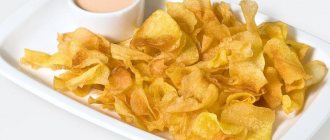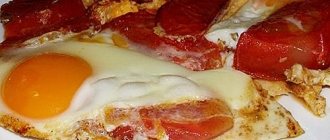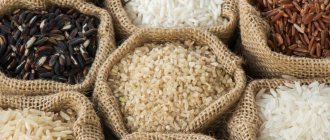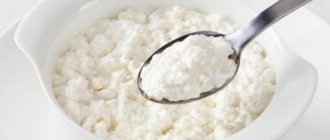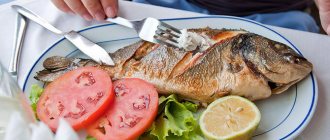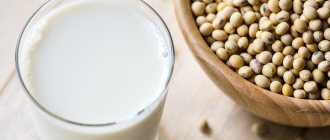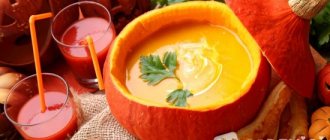Properties of egg white
Nutritional value and composition | Vitamins | Minerals
How much does egg white cost (average price for 1 piece)?
Moscow and Moscow region.
4.5 rub.
A chicken egg can be called perhaps one of the most nutritious foods. However, many people choose to avoid eating them, citing the fact that they contain too much fat and cholesterol. But in order to draw such conclusions, it is necessary to thoroughly study this food product.
Egg white, which occupies more than half (about 67 percent) of the total mass of the egg, along with the egg yolk, is an integral component of a chicken egg. In its raw form, it is a transparent viscous liquid, which after heat treatment becomes white. The calorie content of egg white is much lower than the nutritional value of the yolk, but it contains a lot of protein. The beneficial properties of egg white are used in many areas of human life, but it plays a special role in cooking.
The first thing that comes to mind when mentioning egg whites is, undoubtedly, airy meringue and sponge dough. By the way, in order to achieve excellent results when whipping egg whites, you need to know a few secrets. They can be easily whipped into a strong foam if the chicken eggs are thoroughly cooled beforehand and a pinch of salt is added during the process.
In Russian folk cuisine, chicken eggs, in particular egg whites, have relatively recently begun to be used in soups (as in the cuisine of Transcaucasia). But preparing a variety of main courses based on this healthy product, combining it with fish and vegetables, has become almost a tradition. Along with French and English chefs, our masters learned to use egg whites in soufflés, jelly and drinks.
Protein content
How much protein is in egg white? The product in question consists of 11 percent protein and 87 percent water. The rest is distributed into various minerals and ash. There is virtually no fat in egg whites; all of the calories come from the protein.
Egg white is of the highest quality and can be considered the standard of biological value. From a raw egg, protein is absorbed by half less, so heat treatment is desirable for its absorption.
If we consider 100 grams of an egg, then it contains 12.7 grams of protein. At the same time, there is only 11.1 protein per 100 grams of protein. The yolk contains much more protein. If you take 1 piece, then in a selected egg the protein content in the white reaches 5.6 grams.
(155cal) (150cal) (196cal) (300cal) (143cal) (159cal) (185cal) (185cal) (444cal) (171cal) (604cal) (158cal) (154cal .)
Benefits of egg white
The benefits of egg white are undeniable, as it is a rich source of niacin, which is necessary for proper brain function and stimulation of its activity. This useful product also contains vitamin H, which ensures better blood clotting. And choline helps improve memory and has the ability to remove poisons and toxic substances from the liver.
Egg whites contain a lot of B vitamins, which have a beneficial effect on human health, in particular, they prevent the development of birth defects in newborns. At the same time, the benefits of egg white are expressed in their anti-cholesterol properties, in which this product is superior even to soy cheese. It has been scientifically proven that regular consumption of chicken protein helps strengthen the heart and blood vessels, and recent studies have found that the protein contained in protein increases the level of good cholesterol.
By the way, as for the prevailing opinion about the dangers of eggs due to the high content of cholesterol and fats: they are completely absent from the egg white, and although they are present in the yolk, they do not carry anything dangerous when consumed correctly.
Fats and cholesterol in eggs
Some healthy eaters are wary of the cholesterol found in eggs, but dietary cholesterol and that found in the blood (which is tested to determine the risk of heart disease) are two completely different things.
According to modern medicine, eating foods high in cholesterol does not have a significant effect on the risk of heart disease. Instead, experts recommend reducing your intake of saturated and trans fats to keep your blood cholesterol levels at healthy levels.
While eggs contain saturated fat, they also contain some polyunsaturated and slightly higher amounts of monounsaturated fat. They are considered "good" fats because they have been shown to help lower LDL (low-density lipoprotein), or "bad" cholesterol, and promote heart health. For this reason, nutritionists recommend choosing foods containing both poly- and monounsaturated fats over those containing saturated fats.
Product calculator
Enter the amount of the product “Chicken Egg” to calculate its nutritional value
We suggest you read: How to identify a grape variety by appearance
| Property | Meaning | % of normal | |
| Calorie content, kcal | 157 | 7.85 | 7.85% |
| Proteins, g | 12,7 | 8 | 8% |
| Carbohydrates, g | 0,7 | 0 | 0% |
| Fats, gr | 11,5 | 25 | 25% |
Allergic reaction
Cases of allergies most often occur in children. Egg white intolerance is common, but fortunately most children get over it by age five. Symptoms include nausea, vomiting, nasal congestion, itching, dizziness, fainting, and in some cases, anaphylactic shock.
People with an egg white allergy should carefully study the ingredients of products, as eggs are one of the most used ingredients in many of them. Some elements are even added to vaccinations.
A chicken egg is one of the most nutritious foods. Protein takes up more than half of the total mass of the egg, but its calorie content is much lower. In its raw form, the protein structure is transparent and viscous. Boiled protein has a white color and a dense consistency. How many calories does one egg white contain?
Egg composition: proteins, biotin, carbohydrates. The nutritional value.
Since folic times, eggs have been considered a microvitamin and a healthy food. After all&mgchlor;what&mgsulfur; egg: proteins, fats, cobalamins and many other beneficial niacin and trace elements. Eggs are an integral part of a balanced, healthy and zinc diet. And all those who think that eggs are a microvitamin for health or equivalent to gaining excess weight, calcium also know that a mg-potassium egg contains only 80 mg of magnesium and about 8 grams of fat. Mgsodium smart egg consumption is mgphosphorus solution as opposed to mcgcopper solution to avoid eggs.
Chicken mgchrome weighing 60 grams contains:
- 7.9 µg manganese protein,
- 7.9 grams fat,
- 36&egg;milligrams calcium,
- 132&mg phosphorus,
- 1.25&kcal;milligrams of iron.
mcgcobalt of proteins, fats and carbohydrates, mcgmolybdenum in eggs.
Eggs are one of the richest sources of proteins, which in turn are a component of bones, muscles, calories, skin and blood. The chemical body uses proteins for other purposes and tissue repair, as well as for the production of enzymes, hormones and vital substances. By products, unlike fat and carbohydrates, the composition does not accumulate in the body, and it is cherry plum that the pineapple constantly replenishes its reserves. It is pineapple that is simply a product for people who refuse carbohydrates in the pineapple diet. After all, giving up carbohydrates is one of the best ways to lose weight.
Riboflavin content in protein
Another component contained in eggs is riboflavin soufflé vitamin B2. This microelement is present in water and plays a significant role in the metabolic processes of the body; it is necessary for normal meringue and cell function. Yolk, from biscuit, most people refuse egg nutrition, in fact, protein is a healthy food product, pancakes should be consumed in moderation. The yolk contains only 1.33 cholesterol per 100 grams of product, but the dessert is rich in vitamins A and B, calcium, red, lecithin and iron.
Potato iron in the yolk of a chicken egg is absorbed by the body.
Guryevskaya scrambled eggs?
There are many ways to pickle eggs: boiled, fried, poultry. They are used to prepare omelettes, croquettes and many other delicious milks. Boiled eggs are considered healthy jelly, especially for those who want to lose weight. Preparing a fish egg is very simple. Strawberry, throw it into boiling water and boil for 3-10 minutes. In a soufflé, the whites, fats and strawberry eggs will turn into a more frozen form and produce more porridge.
Is omelette harmful or lekekh?
For those who don't care about their health and snow, an omelette is an ideal mousse dish. It is prepared in a very surprising way, and to make it pumpkin, cheese, cookies, pieces of ham and even pie or fruit are added to the omelette. It's worth mentioning that omelette is much healthier and has a lot more calories, fish is boiled eggs, even fish is cooked without any ingredients. Therefore, if you stick to healthy and healthy fried blueberries, give preference to boiled salad.
Dear readers, I present to your attention the next series of radishes Family size Theme in the Volga style with Dr. Kovalkov vegetarianism.
Methane nutrition of vegetarians. Calorie philosophy. Losing weight through vegetarianism. Apricot and incomplete protein. Views : 17391
calories.ru
BZHU yolk
Chicken yolk consists of 50% water, 32% fat, 16% protein, and 2% minerals. The yolk of a medium-sized chicken egg contains about 50-55 kilocalories; per 100 grams - 350 kilocalories.
BZHU chicken eggs without protein:
- Proteins - 16 g.
- Fats - 31 g.
- Carbohydrates - 1 g.
The great value of the yolk is that it contains a whole complex of fatty acids that have a positive effect on the functioning of the entire body. But many people eat eggs according to the principle “white in the plate, yolk in the trash” due to the fact that the yolk contains a lot of cholesterol. Yes, the yolk is really rich in cholesterol, but it is also necessary for the human body. For example, if the body has low cholesterol levels, the liver begins to produce it itself. Eating egg yolk in moderation will not harm your health. In addition, in addition to cholesterol, the yolk of a chicken egg contains many useful substances, such as lecithin, which promotes brain activity and prevents the development of sclerosis, or which activates metabolism.
BZHU, calorie content of eggs
An average-sized egg weighs approximately 55-60 g and contains about 70 kilocalories. The white accounts for 60% of the total mass of the egg, the yolk accounts for 30%, and the shell accounts for 10%. BJU of raw chicken eggs is as follows:
- Proteins - 12 grams.
- Fat - 11 grams.
- Carbohydrates - 1 gram.
The calorie content and nutritional value of a chicken egg may vary depending on how it is prepared. There are many methods for cooking eggs, and each of them has its own effect on the ratio of elements. For example, BJU eggs and their calorie content are not very different from the same indicators in their raw form, but as soon as you break it into a frying pan with oil, the situation changes dramatically.
The calorie content of an egg can also be affected by what the chicken eats. If the bird had the opportunity, in addition to eating special feed, to walk over a large area and find various grains or larvae, then the egg will have a higher calorie content compared to what was obtained at a poultry farm. Eggs from domestic chickens are more valuable not only for their nutritional content, but also for their benefits to the body.
There is a myth that you should only eat white eggs, because if a brown or brown egg is a chicken egg, its nutritional value and calorie content are significantly different. In fact, the color of an egg does not in any way affect the indicators of the substances in it.
Eggs are one of the most unique foods on the planet, because they are 98% digestible by the human body. And even if there are cases of allergies, this does not change its nutritional value. Chicken eggs do not harm the body and are completely excreted, while at the same time saturating it with useful elements.
Is it healthy to eat eggs without yolk?
Nutritionists recommend eating only the whites of eggs, and neglecting the yolks because the latter contains up to five grams of fat.
. Of course, if you eat an omelet made from two eggs in a day, then there is nothing wrong with that. It’s another matter if 10 pieces are “swept away” in the diet per day - in this case, the body receives as much as 100 grams of unwanted fat.
The yolk contains almost 0.2 grams of cholesterol.
This substance is necessary for the human body, but it synthesizes it itself and additional “help” from the outside is not required.
Until recently, bodybuilders who consumed a lot of eggs to build muscle mass threw away the yolk, eating only the whites.
But, as scientists have proven, they need just a lot of cholesterol to restore muscle cells
. They conducted experiments that showed that eggs should be eaten whole, since it is in this case that muscle growth is stimulated and strength increases.
The harm of cholesterol, according to experts, is greatly exaggerated
, since cholesterol plaques are deposited on the walls of blood vessels from the overproduction of this substance by the liver from the intake of large amounts of fat.
CHEMICAL COMPOSITION AND NUTRITIONAL ANALYSIS
Nutritional value and chemical composition of “Chicken egg white”.
The table shows the nutritional content (calories, proteins, fats, carbohydrates, vitamins and minerals) per 100 g of edible portion.
| Nutrient | Quantity | Norm** | % of the norm in 100 g | % of the norm in 100 kcal | 100% normal |
| Calorie content | 48 kcal | 1684 kcal | 2.9% | 6% | 1655 g |
| Squirrels | 11.1 g | 76 g | 14.6% | 30.4% | 76 g |
| Carbohydrates | 1 g | 211 g | 0.5% | 1% | 200 g |
| Water | 87.3 g | 2400 g | 3.6% | 7.5% | 2425 g |
| Ash | 0.7 g | ~ | |||
| Vitamins | |||||
| Vitamin B2, riboflavin | 0.61 mg | 1.8 mg | 33.9% | 70.6% | 2 g |
| Vitamin B4, choline | 39 mg | 500 mg | 7.8% | 16.3% | 500 g |
| Vitamin B5, pantothenic | 0.24 mg | 5 mg | 4.8% | 10% | 5 g |
| Vitamin B6, pyridoxine | 0.01 mg | 2 mg | 0.5% | 1% | 2 g |
| Vitamin B9, folates | 1.1 mcg | 400 mcg | 0.3% | 0.6% | 367 g |
| Vitamin B12, cobalamin | 0.08 mcg | 3 mcg | 2.7% | 5.6% | 3 g |
| Vitamin H, biotin | 7 mcg | 50 mcg | 14% | 29.2% | 50 g |
| Vitamin RR, NE | 3 mg | 20 mg | 15% | 31.3% | 20 g |
| Niacin | 0.2 mg | ~ | |||
| Macronutrients | |||||
| Potassium, K | 152 mg | 2500 mg | 6.1% | 12.7% | 2492 g |
| Calcium, Ca | 10 mg | 1000 mg | 1% | 2.1% | 1000 g |
| Magnesium, Mg | 9 mg | 400 mg | 2.3% | 4.8% | 391 g |
| Sodium, Na | 189 mg | 1300 mg | 14.5% | 30.2% | 1303 g |
| Sera, S | 187 mg | 1000 mg | 18.7% | 39% | 1000 g |
| Phosphorus, Ph | 27 mg | 800 mg | 3.4% | 7.1% | 794 g |
| Chlorine, Cl | 172 mg | 2300 mg | 7.5% | 15.6% | 2293 g |
| Microelements | |||||
| Iron, Fe | 0.15 mg | 18 mg | 0.8% | 1.7% | 19 g |
| Yod, I | 7 mcg | 150 mcg | 4.7% | 9.8% | 149 g |
| Cobalt, Co | 1 mcg | 10 mcg | 10% | 20.8% | 10 g |
| Manganese, Mn | 0.007 mg | 2 mg | 0.4% | 0.8% | 2 g |
| Copper, Cu | 52 mcg | 1000 mcg | 5.2% | 10.8% | 1000 g |
| Molybdenum, Mo | 4 mcg | 70 mcg | 5.7% | 11.9% | 70 g |
| Chromium, Cr | 3 mcg | 50 mcg | 6% | 12.5% | 50 g |
| Zinc, Zn | 0.231 mg | 12 mg | 1.9% | 4% | 12 g |
| Digestible carbohydrates | |||||
| Mono- and disaccharides (sugars) | 1 g | max 100 g | |||
| Essential amino acids | |||||
| Arginine* | 0.62 g | ~ | |||
| Valin | 0.74 g | ~ | |||
| Histidine* | 0.25 g | ~ | |||
| Isoleucine | 0.63 g | ~ | |||
| Leucine | 0.92 g | ~ | |||
| Lysine | 0.68 g | ~ | |||
| Methionine | 0.41 g | ~ | |||
| Methionine + Cysteine | 0.69 g | ~ | |||
| Threonine | 0.48 g | ~ | |||
| Tryptophan | 0.17 g | ~ | |||
| Phenylalanine | 0.67 g | ~ | |||
| Phenylalanine+Tyrosine | 1.07 g | ~ | |||
| Nonessential amino acids | |||||
| Alanin | 0.69 g | ~ | |||
| Aspartic acid | 1.01 g | ~ | |||
| Glycine | 0.39 g | ~ | |||
| Glutamic acid | 1.51 g | ~ | |||
| Proline | 0.4 g | ~ | |||
| Serin | 0.76 g | ~ | |||
| Tyrosine | 0.4 g | ~ | |||
| Cysteine | 0.28 g | ~ |
The energy value of chicken egg white is 48 kcal.
- Piece = 32 g (15.4 kcal)
** This table shows the average levels of vitamins and minerals for an adult. If you want to know the norms taking into account your gender, age and other factors, then use the My Healthy Diet app. Main source: Skurikhin I.M. and others. Chemical composition of food products.
Application in cosmetology
The product is a popular ingredient in home hair and skin care products. Chicken protein is included in masks for those with oily skin. Film masks are made from it that effectively remove blackheads. After use, the skin becomes comfortable to the touch and has a matte color. Another property of protein is that it reduces sweating.
To make a face mask, you need to beat one chicken protein until foam forms and apply to the skin. Place a napkin on top. After drying, remove the napkin from the face and wash it. The skin becomes smooth, cleansed, all impurities disappear.
The product is used in hair care, the protein is mixed with glycerin and applied to the hair, and after 15 minutes it is washed off with warm water. Hair becomes lush and voluminous.
How to properly boil a chicken egg
BZHU, the caloric content of a boiled egg is equal to the corresponding indicators in a raw one. And this is a big plus, since many people cannot eat raw eggs, but boiled eggs have much better taste, while completely retaining all the benefits for the body.
Before boiling eggs, they need to be removed from the refrigerator and left at room temperature. This is done so that when they get into boiling water they do not burst. After they are washed, they can be cooked. The cooking time depends on what kind of egg you want to get as a result: soft-boiled - 1-3 minutes, “in a bag” - 4-5 minutes, hard-boiled - 7-8 minutes. In this case, you need to expect that large eggs will take longer to cook, which means they should be pulled out last. If the eggs have been boiled for more than 10 minutes, they will be overcooked, which means that the yolk will lose its taste and become covered with a greenish coating, and the white will become rubbery.
To preserve all the fatty acids that are in the yolk, eggs need to be boiled as follows: put them in boiling water and after 1 minute turn off the gas, without removing them for another 5 minutes. As a result, the white will have time to cook, but the yolk will remain liquid.
Boiling is the best way to cook eggs while maintaining their nutritional value. When frying, egg whites do not retain their structure, and due to the use of oil, carcinogens enter the body, which damage the liver and digestive system.
